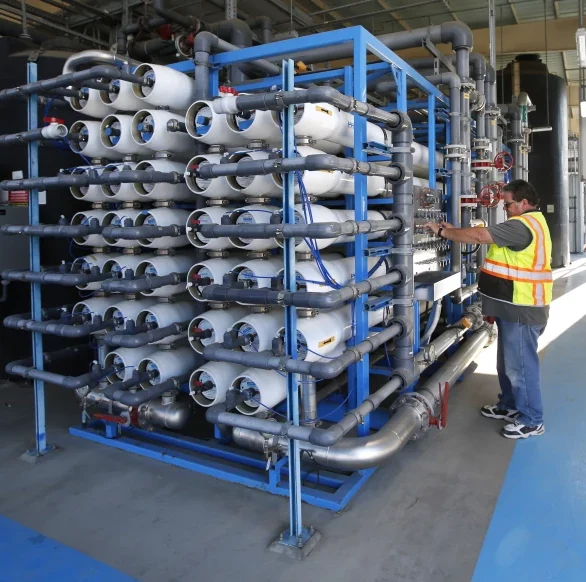
Construction of sewage recycling pipeline expected to disrupt neighborhoods this summer, fall
Neighborhoods across northern San Diego will be disrupted by tunneling and pipeline construction this summer when work kicks into high gear on Pure Water, the largest infrastructure project in city history.
With contracts totaling more than $1 billion recently awarded for eight of the 10 major projects that make up Pure Water’s first phase, city officials say nearly the entire project will be under construction starting in late summer or early fall.
Meanwhile, city officials are preparing to make key decisions soon on the second phase of Pure Water, which is slated for construction in the 2030s.
Pure Water is a sewage recycling system that aims to boost local water independence in the face of more severe droughts caused by climate change. When complete in 2035, it is projected to produce half the city’s drinking water.
Phase one, including a sewage purification plant in western Miramar, will produce 34 million gallons per day of potable drinking water. Phase two, slated to include a purification plant in Mission Valley, will produce 53 million gallons a day.
Despite pandemic-related challenges such as worker shortages and supply chain problems, city officials say contractors are ready to start building Pure Water’s major projects — pump stations, purification plants, and 30 miles of pipeline.
“It’s going to be a busy, busy year,” said James Nagelvoort, head of a new Strategic Capital Projects Department the city is creating to oversee large and complex undertakings like Pure Water.
One key project is a $110 million pump station just north of Interstate 8 and east of Interstate 5 near Morena Boulevard. Millions of gallons of sewage will be pumped northward to the Miramar purification plant through long pipelines.
Creation of $95 million worth of pipelines will include tunneling under freeways and laying pipes through neighborhoods, which is expected to cause traffic delays and some road closures.
“We are building a massive facility and people are living in those neighborhoods,” Nagelvoort said. “We have to work around them and work to coordinate all of that.”
A second pump station will be built in conjunction with the Miramar purification facility for a total project cost of $357 million.
That pump station will propel treated sewage through a $123 million pipeline down Miramar Road, through Mira Mesa, and into Lake Miramar in Scripps Ranch. The project will include tunnels under Interstate 15 and Lake Miramar.
Nagelvoort said “working groups” in affected neighborhoods — Morena, Clairemont, University City, Miramar, and Scripps Ranch — will soon begin meeting more frequently to keep residents and merchants up to date on timelines.
The city has also posted an interactive map at purewatersd.org that will be regularly updated with construction areas, road closures, and detours. In addition, web pages and fact sheets have been created for each construction project.
Contractors are required to update properties within 500 feet of construction with door hangers. And the city has created three hotlines for affected neighborhoods: one for Morena and Clairemont, one for University City, and one for Miramar and Scripps Ranch.
The city is also hiring a separate contractor to coordinate schedules for each of the individual projects to make sure they finish on time. If one project is delayed, the entire system won’t be able to begin operating as scheduled in 2025.
“It’s 10 construction projects, but it’s one gigantic project,” Nagelvoort said. “The system doesn’t function without all 10 pieces being built correctly.”
Meanwhile, the city’s Public Utilities Department is facing some big decisions about the second phase of Pure Water.
City officials announced this spring that the phase two purification plant will be located on a vacant 17-acre site in eastern Mission Valley. But they haven’t yet decided where to store the purified sewage from that plant.
The two leading options, Lake Murray and the San Vicente Reservoir, each come with positives and negatives.
Lake Murray is closer to Mission Valley and would shrink the length and cost of pipeline construction, but
it might be too small.
“The concern there is being able to maintain some level of operational flexibility,” said Amy Dorman, assistant director of Public Utilities.
The problem with San Vicente, which has much more capacity, is the distance and other pipeline challenges such as passing through multiple jurisdictions.
“Some of those corridors are really tight,” Dorman said. “It could be challenging to squeeze another large diameter [pipeline] among a lot of other pipelines already in the right of way.”
Dorman said city officials hope to have a decision by fall.
“There is a lot to consider here and the team is working through these issues,” she said.
A demonstration project showing phase two is technically viable is slated to be built near the Point Loma sewer plant, she said.
